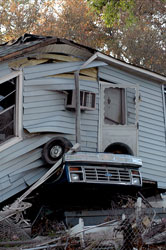Seven months later, where is the help?
After taking a week during spring break with 1,300 other college students to gut houses in New Orleans, I am still amazed at the amount of work needing to be done. As you approach the Ninth Ward, the hardest hit area, and coincidentally home to the poorest people, you can still sense death in the atmosphere. Homes still lie in piles of rubble and power lines hang like black snarling snakes from huge broken twisted trees, with clothing and bedding hanging from the limbs. Hundreds of cars are piled on top of each other, and houses lifted from their foundations sit on top of them. Cadaver dogs are still being used to find bodies under the rubble that is so enormous, it resembles small mountains of brick and boards, with smashed cars sitting on top like some kind of monument to the destruction that Katrina left in her wake, seven months ago. In the nation of opportunity and richness with more money than most countries, why are people still forced to live like this? I do not understand what is happening, or why more hasn’t been done in seven months! In interviews with several individuals in New Orleans, the main question is why. Many churches, schools, community service groups, and individuals have been going down to the hardest hit areas in Louisiana and other Gulf states since Hurricanes Rita and Katrina hit in August 2005. Camps have been set up to feed the homeless and poor, and many types of aid have been offered through volunteers. But, the question still remains. Why is it still so bad? James Breland, one of the community survivors who lost his home, said, “Things have been dragging along for so long we felt like giving up, until the teenagers started coming down and making things happen quicker. We are so grateful, you can’t imagine.” Albert D. Laque, president and governor of St. Charles Parish, La., said, “Thank you so much for all your help, and please tell the other students what a good thing they are doing to help the other parish and communities. We are so grateful. Since the college students have come in, things have progressed quickly, and we appreciate anyone who is willing to come on down.” One thing I noticed from the areas we helped and while traveling through different areas, is it appears most of the help is going to the French Quarter and the downtown areas first, to help the economy. However, the poorest people without insurance or any hope for raising the $5,000 to hire a contractor to gut out the trashed homes are seemingly the ones most overlooked. According to Sammy Pugh, a contractor from West Virginia working for the Army Corp of Engineers in New Orleans, “Things have been pretty slow around here until the college students arrived. Man, they mean business. They have hundreds of houses gutted out every day, and then we can come in and clean up the piles of rubble, stretching for miles through the towns.” He said, “I’ve never seen anything like it, but if they can do it, anyone can and should.” I walked through the Ninth Ward sad and sickened by the destruction and the broken lives still impacted. I can not understand the neglect after seven months. Twenty bulldozers and 50 dump trucks could have the area cleared by now. Doesn’t someone have the resources and manpower to help? I have my summer vacation planned to return. Even if I have to take a hammer and crowbar with just a small group of friends, we can tackle one house at a time. As I dug through the rubble to find a picture and plaque with a poem entitled “Mother” for the owner, I realized I had been touched forever by the lives lost, struggling to rebuild amidst the destruction. All she cared about was her pictures of her children and parents, and grandchildren, and her memories that were ripped away in a moment of horror as death cries were silenced around her. I hugged her through tears and vowed to return as soon as I can, for I too am a mother.
|
